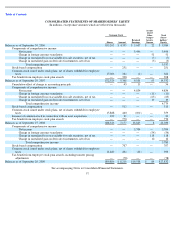Apple 2009 Annual Report Download - page 66
Download and view the complete annual report
Please find page 66 of the 2009 Apple annual report below. You can navigate through the pages in the report by either clicking on the pages listed below, or by using the keyword search tool below to find specific information within the annual report.
Table of Contents
relative fair value of each element. Each element’
s allocated revenue is recognized when the revenue recognition criteria for that element have
been met. Fair value is generally determined by vendor specific objective evidence (“VSOE”),
which is based on the price charged when each
element is sold separately. If the Company cannot objectively determine the fair value of any undelivered element included in a multiple-
element
arrangement, the Company defers revenue until all elements are delivered and services have been performed, or until fair value can objectively
be determined for any remaining undelivered elements. When the fair value of a delivered element has not been established, but fair value exists
for the undelivered elements, the Company uses the residual method to recognize revenue if the fair value of all undelivered elements is
determinable. Under the residual method, the fair value of the undelivered elements is deferred and the remaining portion of the arrangement fee
is allocated to the delivered elements and is recognized as revenue.
For both iPhone and Apple TV, the Company has indicated it may from time-to-
time provide future unspecified features and additional software
products free of charge to customers. Accordingly, iPhone handsets and Apple TV sales are accounted for under subscription accounting in
accordance with GAAP. As such, the revenue and associated cost of sales are deferred at the time of sale, and are both recognized on a straight-
line basis over the currently estimated 24-
month economic life of these products, with any loss recognized at the time of sale. Costs incurred by
the Company for engineering, sales, marketing and warranty are expensed as incurred.
The Company records reductions to revenue for estimated commitments related to price protection and for customer incentive programs,
including reseller and end-user rebates, and other sales programs and volume-
based incentives. The estimated cost of these programs is accrued
as a reduction to revenue in the period the Company has sold the product and committed to a plan. The Company also records reductions to
revenue for expected future product returns based on the Company’
s historical experience. Revenue is recorded net of taxes collected from
customers that are remitted to governmental authorities, with the collected taxes recorded as current liabilities until remitted to the relevant
government authority.
Generally, the Company does not offer specified or unspecified upgrade rights to its customers in connection with software sales or the sale of
extended warranty and support contracts. When the Company does offer specified upgrade rights, the Company defers revenue for the fair value
of the specified upgrade right until the future obligation is fulfilled or the right to the specified upgrade expires. A limited number of the
Company’
s software products are available with maintenance agreements that grant customers rights to unspecified future upgrades over the
maintenance term on a when and if available basis. Revenue associated with such maintenance is recognized ratably over the maintenance term.
Allowance for Doubtful Accounts
The Company records its allowance for doubtful accounts based upon its assessment of various factors. The Company considers historical
experience, the age of the accounts receivable balances, credit quality of the Company’
s customers, current economic conditions, and other
factors that may affect customers’ ability to pay.
Shipping Costs
For all periods presented, amounts billed to customers related to shipping and handling are classified as revenue, and the Company’
s shipping
and handling costs are included in cost of sales.
Warranty Expense
The Company generally provides for the estimated cost of hardware and software warranties at the time the related revenue is recognized. The
Company assesses the adequacy of its preexisting warranty liabilities and adjusts the amounts as necessary based on actual experience and
changes in future estimates. For products accounted for under subscription accounting, the Company recognizes warranty expense as incurred.
63
























